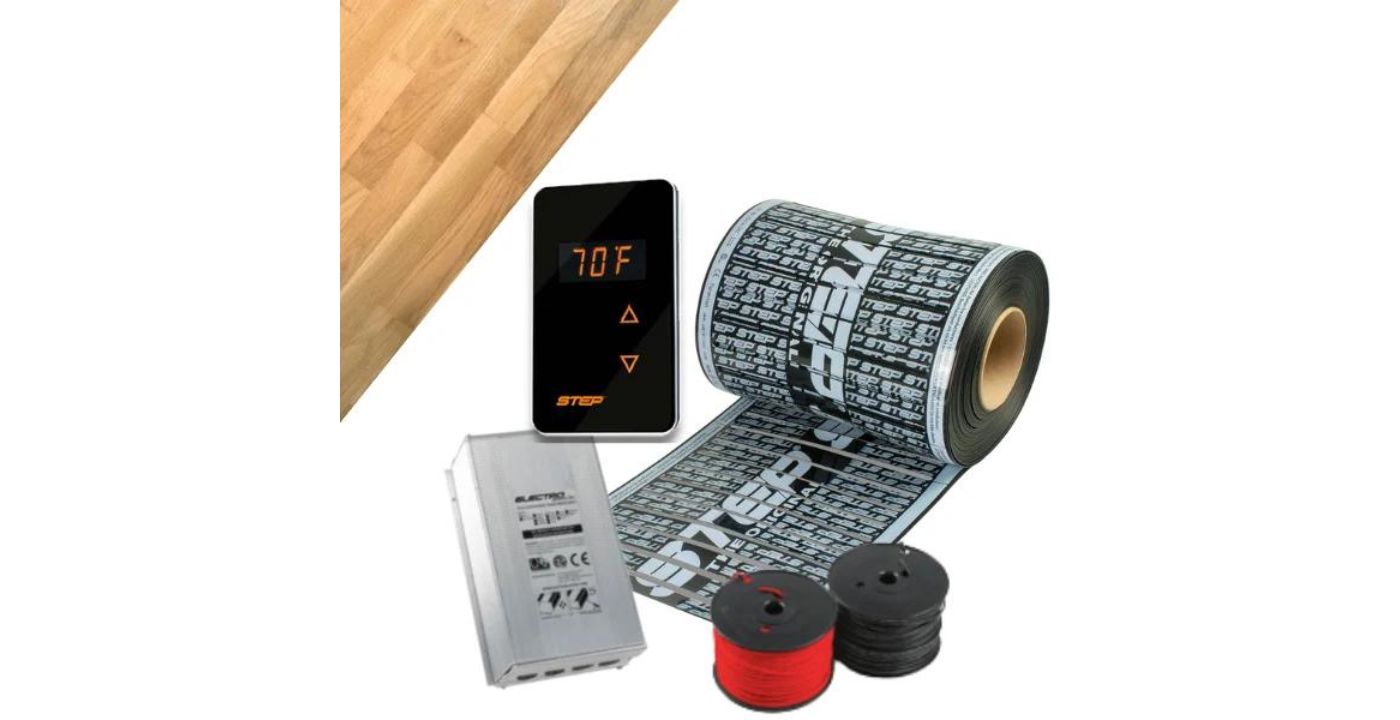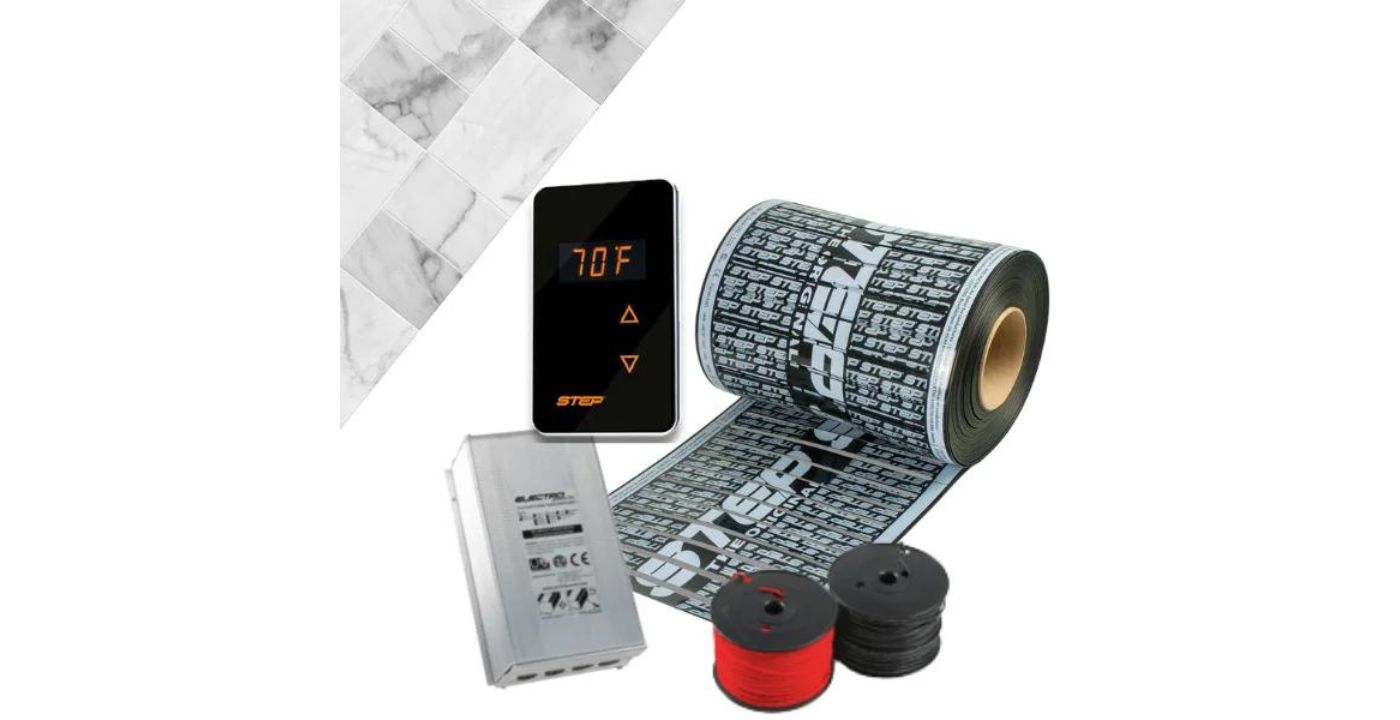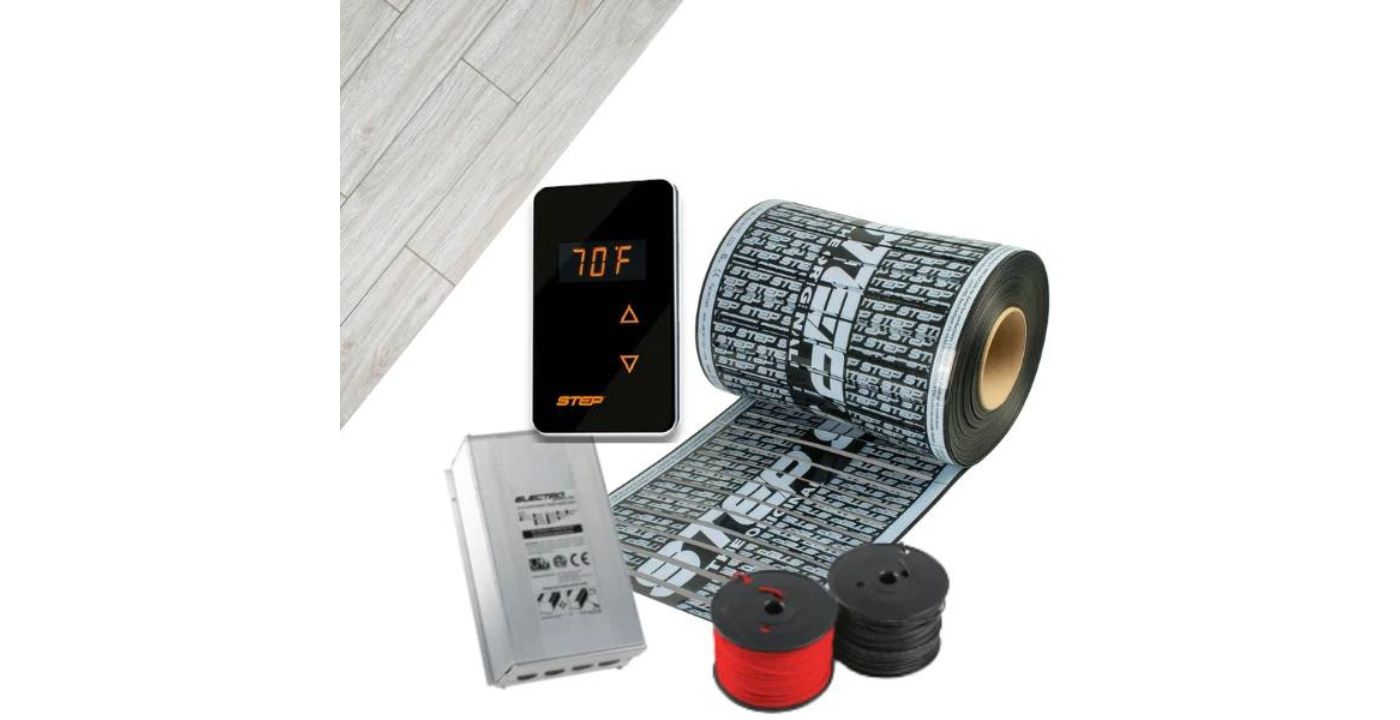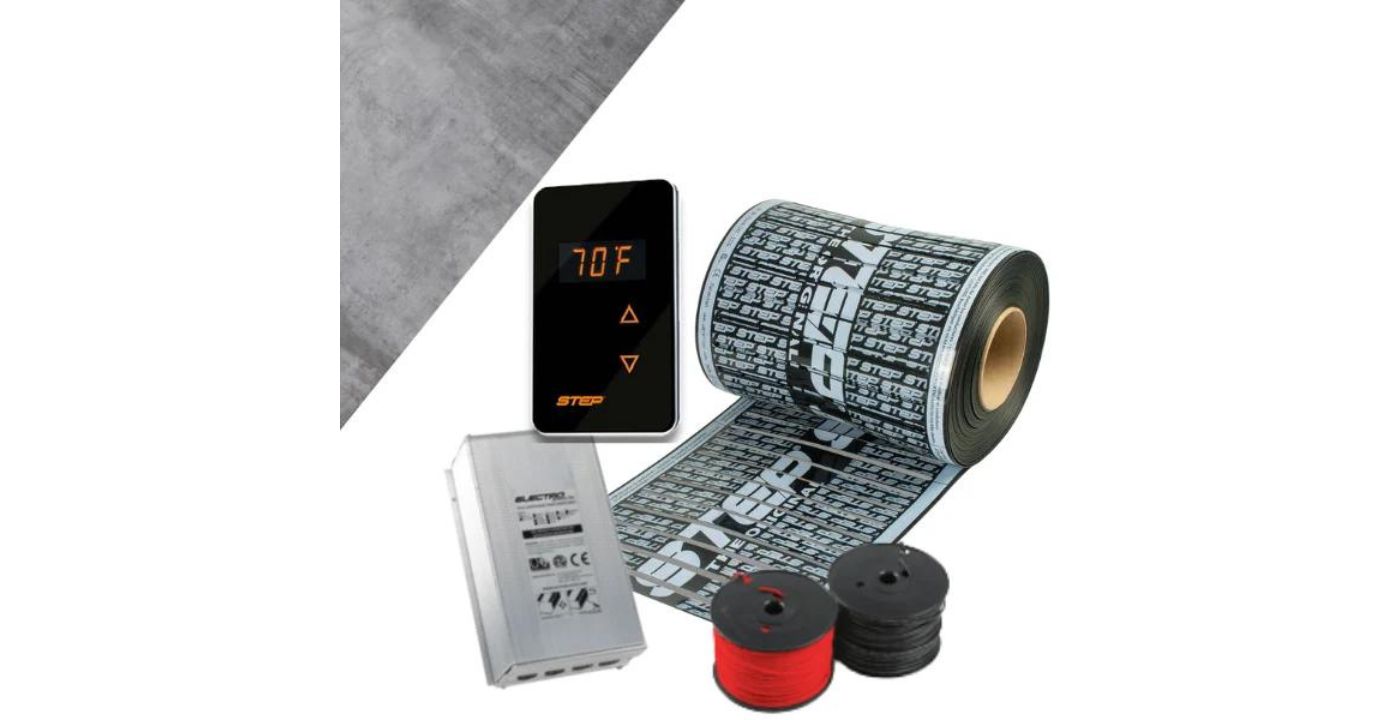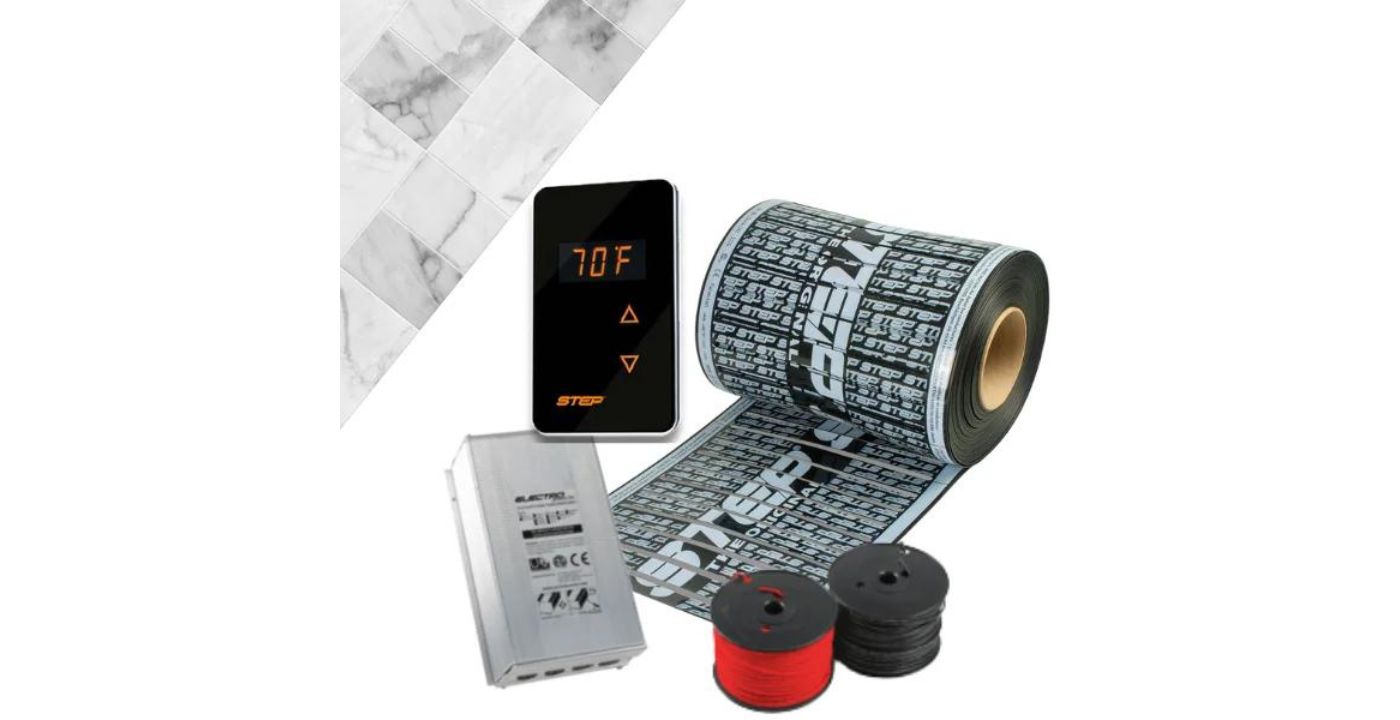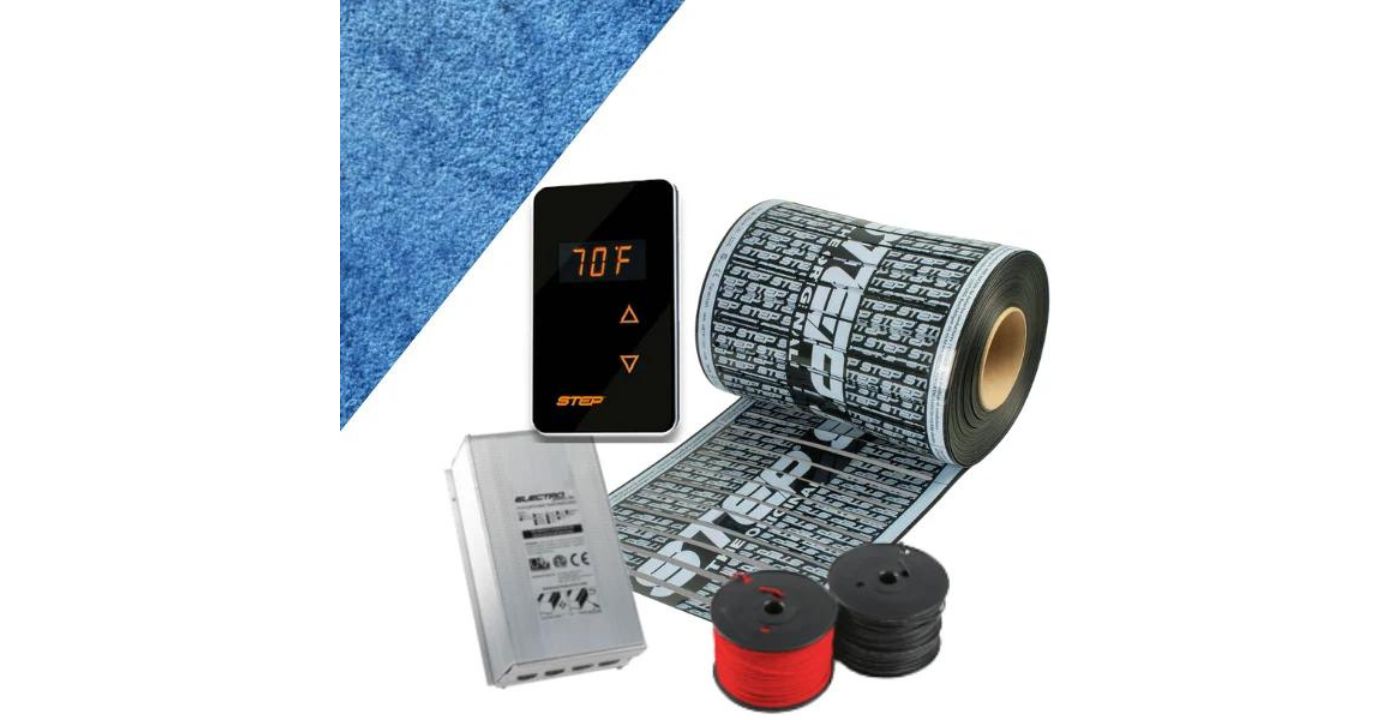Key Takeaways
- Installing a heated kitchen floor will normally cost between $24.40-$70.50 per square foot depending on the scope of the project and the type of flooring material.
- Underfloor heating can be used with carpet, laminate, and vinyl floors.
- Carpet, laminate, and vinyl flooring are the cheapest flooring types to use with in-floor heating systems.
- Most heated floor installation projects typically take between one to three days.
The Cost of Heated Kitchen Floors
The cost of a heated kitchen floor will comprise several different expenses.
Luckily, the cost isn’t as high as many assume. To begin with, the underfloor heating system itself will typically cost around $14 per square foot.
The flooring material is the next factor, with some materials like vinyl costing as little as $2 per square foot.
This price will be higher if you opt for more expensive materials like Marble.
The cost of installation will also vary depending on the type of flooring and the complexity of the layout. However, the usual price range for installation is somewhere between $8–$20 per square foot.
That’s basically it unless your project requires you to replace the existing subfloor ($3–$10 per square foot) and add new underlay ($0.50-$4.50 per square foot).
With all these different factors considered you can normally expect to pay somewhere around $24-$70 per square foot for a fully installed heated kitchen floor.
For an average-sized kitchen in America (approx. 170 square feet) the usual cost range will sit between $4,080 and $11,900 with the higher prices accounted for by using luxury, high-end flooring materials like Marble.
The Benefits of Heated Kitchen Floors
For most people, the primary reason for choosing heated kitchen floors is to increase their comfort in the busiest room in their house.
Typically, kitchens have hard, cold flooring materials, such as tile or wood, and heated floors add warmth and comfort to the room. However, this innovative heating solution offers more than just a unique way to keep your toes feeling toasty.
These are a few of the additional benefits that you will enjoy when you invest in radiant floor heating for your kitchen:
- This type of heating system will improve the air quality in your kitchen. Unlike an HVAC system that recirculates air throughout the room and allows dust, dirt, and dander to travel freely, an underfloor heating solution generates heat using electricity.
- Underfloor heating in your kitchen is more affordable than you might expect. The idea of heating your floors probably sounds very luxurious — and like it would be a significant financial investment — but its cost might surprise you.
- Underfloor heating is one of the most flexible solutions available to consumers today. Depending on the number of exterior walls in your kitchen, this heating solution is an ideal supplemental heat source.
It also can be used as a primary heat source, minimizing your reliance on a traditional heat source, such as a furnace or radiator.
- Radiant floor heating is more efficient than traditional heating solutions, such as a forced air system. By relying on low-voltage electricity, radiant floor heating will quickly heat your room to its desired temperature and retain it for longer.
The cost of operating underfloor heating is much less than running a furnace to heat your entire home.
Heated floors are an invaluable investment you can make in your kitchen. Not only will underfloor heating allow you to enjoy a higher quality of life in your own home, but prospective buyers will be impressed with your heated floors if you ever decide to list your home on the market.
Ultimately, you will likely enjoy a significant return on the investment you made when renovating your kitchen. Either through savings made on electricity bills, or increased value to your home, maybe even both.
Choosing Materials for Your Kitchen Floor Remodel
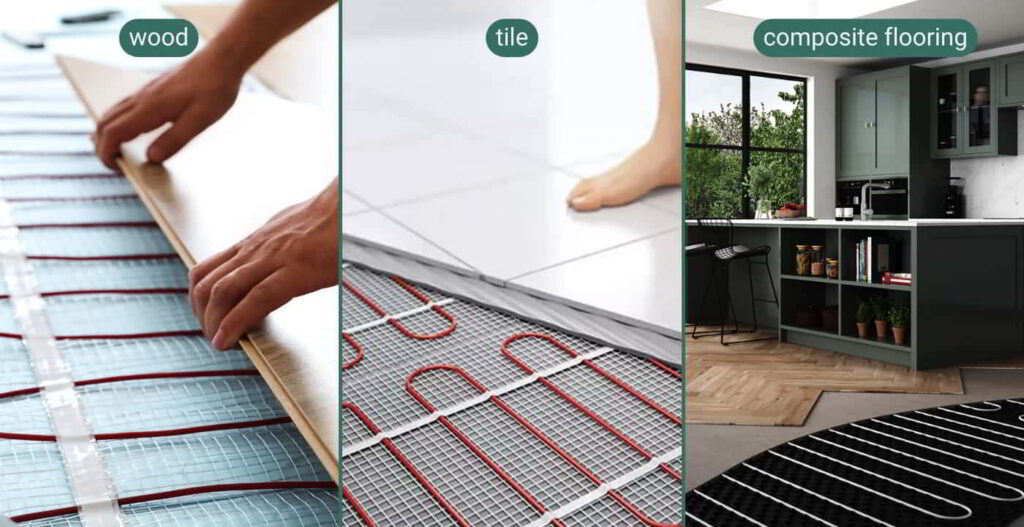
Once you have added underfloor heating to your kitchen renovation project, the next step is determining which flooring materials will work best for your space.
Fortunately, you have a lot of flexibility when choosing flooring materials for your heated kitchen floors, and you will not have to compromise on style, color, or price.
These are the best materials to consider for your heated kitchen floors:
Wood
Natural flooring materials like wood are often the perfect choice for heated kitchen floors.
Wood floors will complement the style and design of your renovated kitchen, heat up quickly, and retain the heat.
Remember that some natural woods are affected by humidity and can warp if exposed to too much moisture.
For the most part, this isn’t an issue in kitchens, but it may be something to consider depending on the location and size of your home.
Wooden Kitchen Floor Installation Process
- Prepare the Subfloor – Ensure it’s clean, dry, and level
- Measure & Plan – Decide on the layout and spacing
- Lay Insulation – Prevent heat loss and direct warmth upwards
- Position & Secure the Mats – Follow the planned layout
- Connect Cables & Test – Ensure a safe electrical connection
- Install Wood Flooring – Adhering to manufacturer’s guidelines
- Final Checks – Re-test the system post-installation
Wooden Kitchen Floor Costs Breakdown
| Project Expense | Cost |
|---|---|
| Hardwood | $6-22/ft² |
| Or | |
| Engineered Wood | $4-16/ft² |
| Plus | |
| System Cost | $14/ft² |
| Plus | |
| Installation Cost | $8-20/ft² |
| Plus | |
| Subflooring Replacement Costs | $3-10/ft² |
| Plus | |
| Underlayment Costs | $0.50-4.50/ft² |
| Total | |
| Low-End Estimate | $29.50/ft² |
| to | |
| Upper-End Estimate | $70.50/ft² |
Tile & Stone
Tile and stone are also attractive choices when considering underfloor heating in your kitchen.
With so many styles and color combinations, tile is often a preferred design option — but it also has the highest thermal conductivity rating.
Both of these flooring materials will heat up quickly and retain the heat for a long time, and beyond that, the heat makes these floors much more comfortable to step on.
Tile & Stone Kitchen Floor Installation Process
- Prepare the Subfloor – Ensure it’s clean, dry, and level
- Measure & Plan – Decide on the layout and spacing
- Lay Insulation – Prevent heat loss and direct warmth upwards
- Position & Secure the Mats – Follow the planned layout
- Connect Cables & Test – Ensure a safe electrical connection
- Install Tile/Stone Flooring – Adhering to manufacturer’s guidelines
- Final Checks – Re-test the system post-installation
Tile Kitchen Floor Costs Breakdown
| Project Expense | Cost |
|---|---|
| Tiles or Stone Flooring | $6-20/ft² |
| Plus | |
| System Cost | $14/ft² |
| Plus | |
| Installation Cost | $8-20/ft² |
| Plus | |
| Subflooring Replacement Costs | $3-10/ft² |
| Plus | |
| Underlayment Costs | $0.50-4.50/ft² |
| Total | |
| Low-End Estimate | $31.50/ft² |
| to | |
| Upper-End Estimate | $68.50/ft² |
Laminate Flooring
Laminate flooring can be viable for heated floors, but you want to involve your radiant floor contractor.
Some hybrid flooring options may have a maximum surface temperature. You will want to verify that these floors will work well with the underfloor heating system you are considering.
Working closely with your heated floor contractor when deciding on your flooring materials is essential. Your contractor can help you determine the best flooring types for your particular kitchen.
Laminate Kitchen Floor Installation Process
- Prepare the Subfloor – Ensure it’s clean, dry, and level
- Measure & Plan – Decide on the layout and spacing
- Lay Insulation – Prevent heat loss and direct warmth upwards
- Position & Secure the Mats – Follow the planned layout
- Connect Cables & Test – Ensure a safe electrical connection
- Install Laminate/Vinyl Flooring – Adhering to manufacturer’s guidelines
- Final Checks – Re-test the system post-installation
Laminate Kitchen Floor Costs Breakdown
| Project Expense | Cost |
|---|---|
| Laminate or Vinyl Plank | $2-7/ft² |
| Or | |
| Luxury Vinyl Plank | $7-10/ft² |
| Plus | |
| System Cost | $14/ft² |
| Plus | |
| Installation Cost | $8-20/ft² |
| Plus | |
| Subflooring Replacement Costs | $3-10/ft² |
| Plus | |
| Underlayment Costs | $0.50-4.50/ft² |
| Total | |
| Low-End Estimate | $27.50/ft² |
| to | |
| Upper-End Estimate | $58.50/ft² |
Concrete Flooring
Concrete floors, celebrated for their robustness and stylish appearance, are gaining popularity in contemporary interior design.
Beyond the aesthetic appeal, they are also excellent for heat retention with underfloor heating systems due to their high thermal mass.
Concrete Kitchen Floor Installation Process
- Prepare the concrete floor
- Arrange the radiant heat mats to completely cover the intended area without any overlaps
- Connect the mats to the thermostat and power supply, ensuring all electrical connections are secure
- If using insulation boards on the subfloor, place them underneath the mats to improve heating efficiency
- Pour concrete over the mats, making sure it fully covers them and is leveled evenly
- Follow the manufacturer’s guidelines to let the concrete cure before using the radiant heating system
Concrete Kitchen Floor Costs Breakdown
| Project Expense | Cost |
|---|---|
| Concrete Flooring | $2-8/ft² |
| Plus | |
| System Cost | $14/ft² |
| Plus | |
| Installation Cost | $8-20/ft² |
| Plus | |
| Subflooring Replacement Costs | $3-10/ft² |
| Plus | |
| Underlayment Costs | $0.50-4.50/ft² |
| Total | |
| Low-End Estimate | $27.50/ft² |
| to | |
| Upper-End Estimate | $56.50/ft² |
Marble Flooring
Marble floors offer unmatched elegance and timeless beauty, making them an exceptional choice for heated kitchen floors.
Beyond their luxurious appearance, marble floors heat up efficiently and distribute warmth evenly, adding a touch of comfort to their aesthetic appeal.
However, it’s important to note that marble can be sensitive to acidic substances and may require more maintenance to preserve its polished look.
Despite this, its durability and the sophisticated atmosphere it lends to any kitchen renovation make it a worthwhile consideration, especially for those looking to elevate the style of their home.
Marble Kitchen Floor Installation Process
- Prepare the Subfloor – Ensure it’s clean, dry, and level.
- Measure & Plan – Decide on the layout and spacing.
- Lay Insulation – Prevent heat loss and direct warmth upwards.
- Position & Secure the Mats – Follow the planned layout.
- Connect Cables & Test – Ensure a safe electrical connection.
- Install Marble Flooring – Adhering to manufacturer’s guidelines.
- Final Checks – Re-test the system post-installation.
Marble Kitchen Floor Costs Breakdown
| Project Expense | Cost |
|---|---|
| Marble Tiles | $5-10/ft² |
| Or | |
| Marble Slabs | $10-20/ft² |
| Plus | |
| System Cost | $14/ft² |
| Plus | |
| Installation Cost | $8-20/ft² |
| Plus | |
| Subflooring Replacement Costs | $3-10/ft² |
| Plus | |
| Underlayment Costs | $0.50-4.50/ft² |
| Total | |
| Low-End Estimate | $30.50/ft² |
| to | |
| Upper-End Estimate | $68.50/ft² |
Carpet Flooring
A widespread myth about radiant floor heating is the belief that it’s exclusively compatible with wood or stone floors.
However, installing radiant floor heating beneath carpeting is not just feasible—it’s actually favored by many homeowners.
A carpet with electric heating underneath becomes warm, welcoming, and exceptionally comfortable, offering additional warmth to the space.
Radiant heating under carpets is often used as the main heating source, especially in rooms built over concrete slabs.
Carpet Kitchen Floor Installation Process
- Prepare the Subfloor – Ensure it’s clean, dry, and level.
- Measure & Plan – Decide on the layout and spacing.
- Lay Insulation – Prevent heat loss and direct warmth upwards.
- Position & Secure the Mats – Follow the planned layout.
- Connect Cables & Test – Ensure a safe electrical connection.
- Lay the carpet – Adhering to manufacturer’s guidelines.
- Final Checks – Re-test the system post-installation.
Carpet Kitchen Floor Costs Breakdown
| Project Expense | Cost |
|---|---|
| Concrete Flooring | $7.9-15/ft² |
| Plus | |
| System Cost | $14/ft² |
| Plus | |
| Installation Cost | $8-20/ft² |
| Plus | |
| Subflooring Replacement Costs | $3-10/ft² |
| Plus | |
| Underlayment Costs | $0.50-4.50/ft² |
| Total | |
| Low-End Estimate | $23.40/ft² |
| to | |
| Upper-End Estimate | $63.50/ft² |
Kitchen Floor Heating Installation
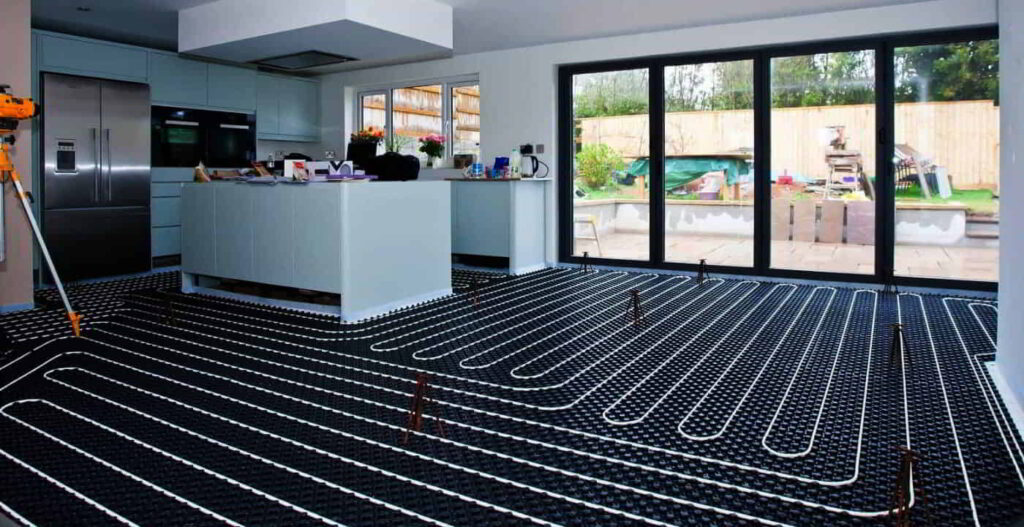
While it is possible for radiant floor heating to be retrofitted to your existing floors, the best time to install this solution is during renovation.
Radiant floor heating installation is surprisingly quick and easy, mainly when you work with an experienced and trusted contractor, such as Green Wave Distribution.
Here are a few things that you need to know about the installation process:
- Before installing, you should review the underfloor heating plan with your contractor. Be sure that the room has been measured and that the contractor has verified the specs for the system. It is best to address any issues with the plan before beginning the installation process.
- Know that the installation typically takes one business day— sometimes less. The contractors will work to clean the subfloor of your kitchen, roll out the heating elements for the radiant floor, and install the thermostat that will control the temperature of the feet.
- Your radiant floor heating contractor is not going to install your flooring materials. However, your contractor will test the radiant floor heating system before installing flooring materials. This allows you to rest easy, knowing that your new heating solution will work properly once your kitchen floors are complete.
- Remember that the installation process could vary based on your chosen flooring materials. For example, different techniques are used for tile and stone flooring versus wood flooring. Your contractor can provide detailed information about your specific project’s installation process.
When you work with the right contractor, your heated floor installation will move smoothly and without issue.
A qualified contractor will install everything properly while respecting your space and ensuring no damage is done to your property.
Partnering with the Best Contractor for Your Ideal Heated Kitchen Floor
Our innovative STEP Heat system is the best in its class, offering our clients an effective heating solution and an opportunity to live more sustainably.
Using automated carbon polymer heating technology, our STEP HEAT radiant flooring solution is safe, efficient, durable, and sustainable.
The STEP Heat system costs $14 per square foot, meaning you can have it installed in your kitchen at prices starting at less than $25 per square foot (depending on the flooring type).
Contact us today for more information about how Green Wave Distribution can help improve your kitchen renovation with underfloor heating solutions.





